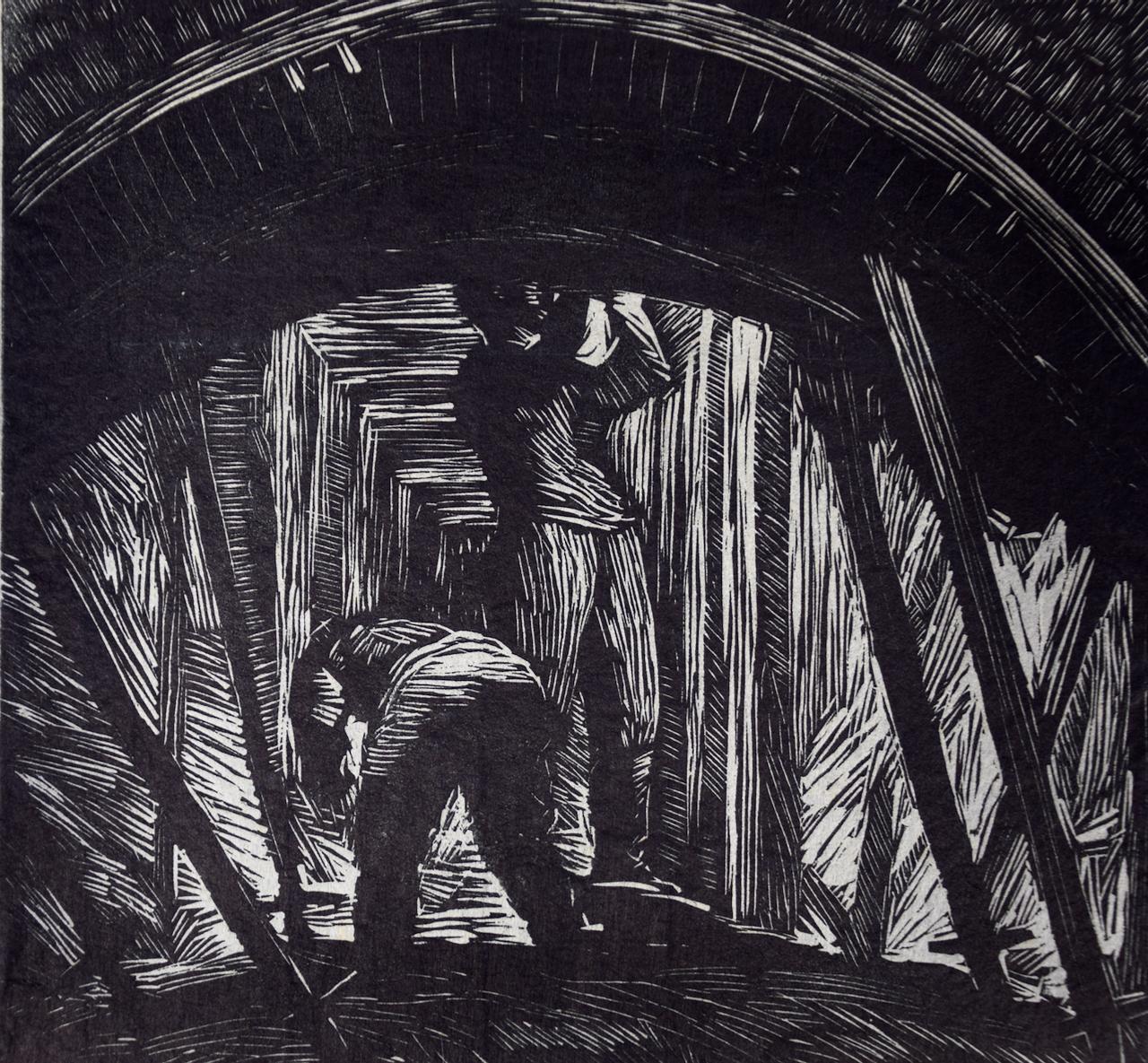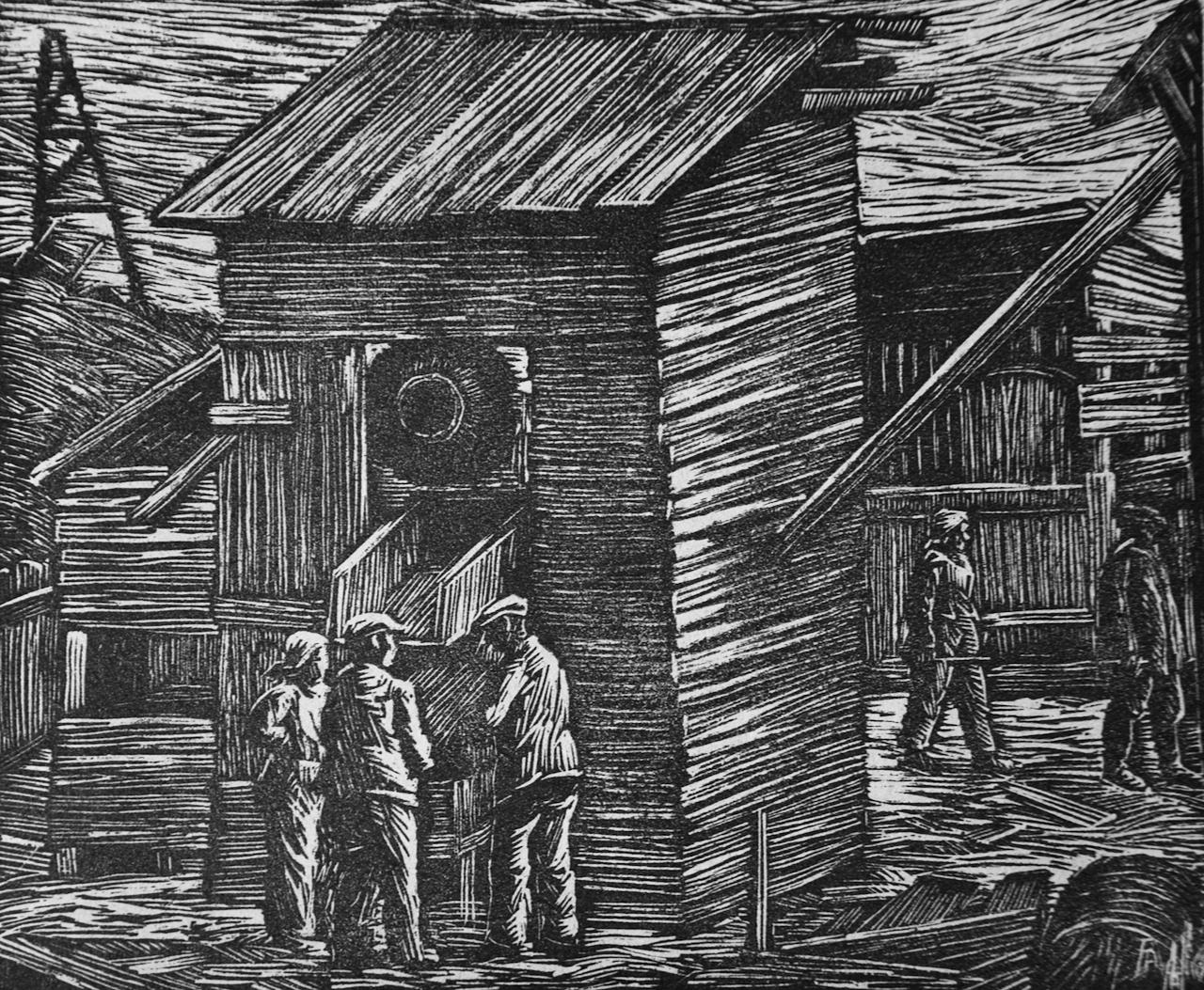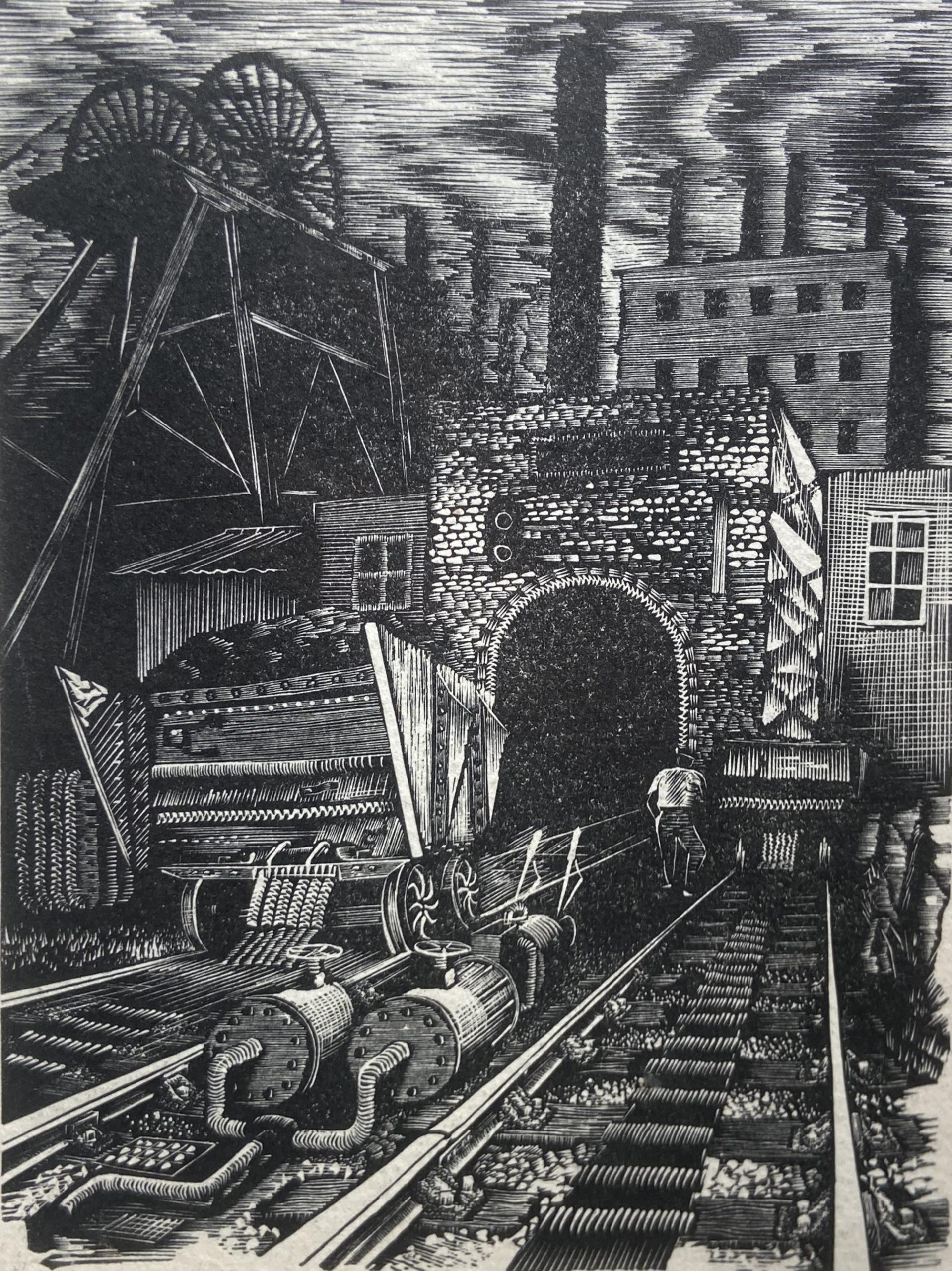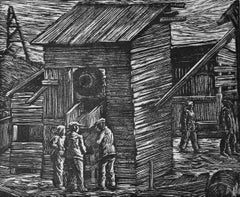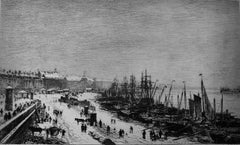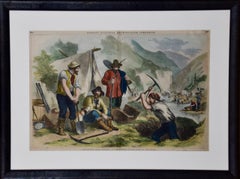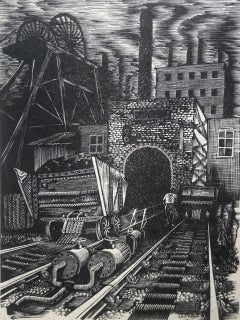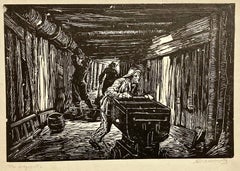Items Similar to "Subway Construction, Moscow": An Early 20th C. Woodcut Engraving by Abramovitz
Want more images or videos?
Request additional images or videos from the seller
1 of 9
Albert Abramovitz"Subway Construction, Moscow": An Early 20th C. Woodcut Engraving by Abramovitz1935
1935
$1,375
£1,027.06
€1,190.71
CA$1,909.15
A$2,139.91
CHF 1,114.19
MX$26,129.28
NOK 14,146.18
SEK 13,409.30
DKK 8,884
Shipping
Retrieving quote...The 1stDibs Promise:
Authenticity Guarantee,
Money-Back Guarantee,
24-Hour Cancellation
About the Item
This is a signed woodcut engraving entitled "Subway Construction, Moscow" created by Albert Abramovitz in 1935, after a trip to the Soviet Union. It depicts many Russian workers actively constructing a two level subway, primarily out of wood.
This is an excellent impression, printed on deckle edge watermarked paper (Hazelbourn Deckle Edge Book), with wide margins. It is pencil signed by the artist in the lower margin on the right and titled in the lower left. The sheet measures 12.75" in height and 14.5" in width. There are remnants of hinge tape at the edge of the sheet in the upper corners and minimal wrinkling in the margin in the lower left corner.
Albert Abramovitz (1879-1963) was a painter and printmaker who was born in Riga, Latvia and studied art at the Imperial Art School in Odessa, Ukraine and in Paris, at the Académie de la Grande Chaumière. He was a member of the Paris Salon, serving on its panel for the review of juried works of art. He was also a member of the Societaire Salon d'Automne. He was awarded the Grand Prize at the 1911 Universal Exposition in Rome and Turin.
In 1916, Abramovitz emigrated to the United States, first living in Manhattan then briefly in Los Angeles in the late 1920's, living in Brooklyn, New York the rest of his lfe. His work was exhibited across the United States in multiple shows and collections. Abramovitz produced murals for the Federal Arts Project Works Progress Administration in New York. His works are in the collections of the Smithsonian Museum of American Art, the British Museum, the Metropolitan Museum of Art, the New York Public Library, the Spencer Museum of Art, the University of Michigan Museum of Art, the Victoria and Albert Museum, and the Library of Congress.
- Creator:Albert Abramovitz (1879-1963, American)
- Creation Year:1935
- Dimensions:Height: 12.75 in (32.39 cm)Width: 14.5 in (36.83 cm)
- Medium:
- Period:
- Framing:Framing Options Available
- Condition:
- Gallery Location:Alamo, CA
- Reference Number:Seller: # 36511stDibs: LU117329410112
Albert Abramovitz
Albert Abramovitz (1879-1963) was a painter and printmaker who was born in Riga, Latvia and studied art at the Imperial Art School in Odessa, Ukraine and in Paris, at the Académie de la Grande Chaumière. He was a member of the Paris Salon, serving on its panel for the review of juried works of art. He was also a member of the Societaire Salon d'Automne. He was awarded the Grand Prize at the 1911 Universal Exposition in Rome and Turin. In 1916, Abramovitz emigrated to the United States, first living in Manhattan then briefly in Los Angeles in the late 1920's, living in Brooklyn, New York the rest of his lfe. His work was exhibited across the United States in multiple shows and collections. Abramovitz produced murals for the Federal Arts Project Works Progress Administration in New York. His works are in the collections of the Smithsonian Museum of American Art, the British Museum, the Metropolitan Museum of Art, the New York Public Library, the Spencer Museum of Art, the University of Michigan Museum of Art, the Victoria and Albert Museum, and the Library of Congress.
About the Seller
5.0
Platinum Seller
Premium sellers with a 4.7+ rating and 24-hour response times
Established in 2011
1stDibs seller since 2019
285 sales on 1stDibs
Typical response time: 2 hours
- ShippingRetrieving quote...Shipping from: Alamo, CA
- Return Policy
Authenticity Guarantee
In the unlikely event there’s an issue with an item’s authenticity, contact us within 1 year for a full refund. DetailsMoney-Back Guarantee
If your item is not as described, is damaged in transit, or does not arrive, contact us within 7 days for a full refund. Details24-Hour Cancellation
You have a 24-hour grace period in which to reconsider your purchase, with no questions asked.Vetted Professional Sellers
Our world-class sellers must adhere to strict standards for service and quality, maintaining the integrity of our listings.Price-Match Guarantee
If you find that a seller listed the same item for a lower price elsewhere, we’ll match it.Trusted Global Delivery
Our best-in-class carrier network provides specialized shipping options worldwide, including custom delivery.More From This Seller
View All"Mine Shaft", Soviet Union: An Early 20th C. Woodcut Engraving by Abramovitz
By Albert Abramovitz
Located in Alamo, CA
This is a signed woodcut engraving entitled "Mine Shaft" created by Albert Abramovitz in 1935, after a trip to the Soviet Union. It depicts two Russian workers constructing a mine sh...
Category
1930s Landscape Prints
Materials
Woodcut
"Concrete Mixer, Moscow": Early 20th C. Woodcut Engraving by Albert Abramovitz
By Albert Abramovitz
Located in Alamo, CA
This is a woodcut engraving entitled "Concrete Mixer, Moscow" by Albert Abramovitz created in 1935 after a visit to the Soviet Union. It depicts three Russian workers talking in front of a wooden structure housing a cement mixer...
Category
1930s Landscape Prints
Materials
Woodcut
The Port Of Bordeaux, France In Winter: A 19th C. Etching by Maxime Lalanne
By Maxime Lalanne
Located in Alamo, CA
This is a mid 19th century etching entitled "Rade de Bordeaux, Janvier" (Port Of Bordeaux In Winter), etched by Phillip Gilbert Hamerton after a drawing by Maxime Lalanne in London in 1868. The etching depicts many boats in the busy harbor of Bordeaux, including small sailboats, as well as tall ships. Another harbor is seen in the distance across the river on the left. Snow covered buildings are on the left and extending long distances in the distant background. Many people occupy the road and ground centrally and on the left along with some horses or mules attached to carts. The sky is a wintery gray.
This etching is an excellent impression printed on thick chain-linked, laid, deckle-edge paper with wide margins, watermarked with a 2 in the lower left corner. It is signed in the plate in the lower left, the title and date are in the center and Bordeaux and the year are included in script along the top of a wall in the lower left of the engraving. The sheet measures 8.75" high by 12" wide. The print is in excellent condition. This etching is held by many museums and institutions, including The National Gallery of Art, Washington, D.C.
François Antoine Maxime Lalanne (1827-1886) was a leading French etcher and painter of landscapes and urban views, who was at the forefront of the French revival of etching during the 1860's. He grew up in Bordeaux, but he refined his artistic skills and worked in Paris. His art was first exhibited at the Paris Salon in 1852 and he continued to regularly show both etchings and paintings there until the mid 1880's. He was also the author of several important books on the subjects of etching and other graphic arts. He was a founding member of the Societe des Aquafortistes, along with Auguste Delatre, Cadart, Ribot and Bracquemond. Lalanne created over one hundred and fifty fine etchings. Lalanne's unique style of art influenced many French and English artists in the twentieth century.
Philip Gilbert Hamerton (1834-1894) was a British artist, art critic and author. He was particularly focussed on contemporary graphic art and printmaking techniques. He frequently wrote about the theory of the English Etching...
Category
Mid-19th Century Landscape Prints
Materials
Etching
"California Gold Diggers": A 19th C. Hand-colored Woodcut Gold Rush Scene
By John Andrew
Located in Alamo, CA
This is a framed hand-colored woodcut engraving entitled "California Gold Diggers - A Scene From Actual Life At The Mines" created by John Andrew and publi...
Category
Mid-19th Century Landscape Prints
Materials
Woodcut
The Beach in Normandy, France, Near Bayeux: A 19th C. Etching by Maxime Lalanne
By Maxime Lalanne
Located in Alamo, CA
This is a mid 19th century etching entitled "Point de Depart de Guillaume de Normandie, Beuzeval, Emboucher de la Dives Calvados (The point of departure of William of Normandy (William the Conqueror)), created by Maxime Lalanne and published in 'L'Illustration Nouvelle' in 1868 by Alfred Cadart. The etching depicts the beach at Beuzeval in Normandy; with the shore in the foreground on the right lined by a row of houses, the sea at the left, and an expansive sky above. There are people on the beach and sailboats in the water. This is the point of departure of William the Conqueror for his voyage to England in 1066, resulting in his victory over the Anglo-Saxons at the Battle of Hastings and the establishment of Norman rule. The events are memorialized in the Bayeux tapestry, created by William's wife.
This etching is presented in a white mat that is suitable for framing. This excellent impression is printed on thick chain-linked, laid cream-colored paper with wide margins. It is signed in plate in the lower right and titled in the plate in the lower left. There is a collector's stamp (either an "NC" or a "CN") in the lower right corner. The sheet measures 9.5" high by 12.75" wide and the mat measures 13.5" high by 16" wide. There are two tiny faint spots in the periphery of the upper margin, but the print is otherwise in excellent condition. This etching is held by many museums and institutions, including The British Museum, The Yale University Art Gallery, The Cleveland Museum of Art, The Philadelphia Museum of Art, Columbia University Libraries and The William Morris Gallery...
Category
Late 19th Century Landscape Prints
Materials
Etching
Winslow Homer 19th Century Woodcut Engraving "Making Hay"
By Winslow Homer
Located in Alamo, CA
This Winslow Homer woodcut engraving entitled "Making Hay", was published in Harper's Weekly in the July 6, 1872 edition. It depicts a two men hand cutting high grass on a hill. The man in the foreground is looking at a young boy and a girl (presumably his children), who are sitting on the ground with a picnic basket.
This beautiful Homer woodcut engraving is presented in a brown wood frame and a light beige fabric mat with a black inner mat. The print is in excellent condition.
There are two other Homer woodcut engravings in identical frames and mats that are listed on 1stdibs. See LU117326148332 and LU117326148272. These would make a wonderful display grouping. A discount is available for the purchase of two or all three of these prints.
This Winslow Homer engraving...
Category
1870s American Impressionist Landscape Prints
Materials
Engraving, Woodcut
You May Also Like
Colliery Scene, Lancashire, 20th Century British Artist, Wood Engraving
Located in London, GB
Wood Engraving on paper, signed and entitled below artwork
Image size: 6 1/4 x 4 1/2 inches (16 x 11.5 cm)
Mounted and framed
This print depicts a scene of a colliery, that is of a ...
Category
20th Century Modern Figurative Prints
Materials
Engraving
Albert Abramovitz, The Wagonette (Moscow Subway)
By Albert Abramovitz
Located in New York, NY
Albert Abramovitz was working in New York in the 1930s when he made wood engravings of the construction of the Moscow subway. This image, The Wagonette, is a wrenching testament to t...
Category
1930s Ashcan School Interior Prints
Materials
Woodcut
Charles Keller Original Stone Lithograph - "6th Avenue Subway”
Located in Phoenix, AZ
Original lithograph by Charles Keller depicting the subway being built in New York
on 6th Avenue in 1937. This print is inscribed lower left: “To W.B.”
The print is in excellent con...
Category
Mid-20th Century More Prints
Materials
Lithograph
The Metro Station in Paris - Original Woodcut by S. Birga - 1994
Located in Roma, IT
The Metro Station in Paris is an original contemporary artwork realized by Sergio Birga (Florence, 1940) in 1994.
Original B/W xylograph on ivory paper. Pa...
Category
1990s Modern Interior Prints
Materials
Woodcut
$225 Sale Price
25% Off
CONCRETE MIXER, MOSCOW
By Albert Abramovitz
Located in Portland, ME
Abramovitz, Albert (American, born Latvia, 1879-1963). CONCRETE MIXER
MOSCOW. Linoleum cut, not dated, but circa 1930s. Edition size not
known. Monogrammed in the block and signed i...
Category
1930s Figurative Prints
Materials
Linocut
Men at Work -Original Etching by George-Henri Tribout - 1940s
By Georges-Henri Tribout
Located in Roma, IT
Men at Work is an original artwork realized by George Henri Tribout.
Original etching on paper.
Signed in plate by the artist on the lower left corner.
George Henri Tribout (Paris...
Category
Mid-20th Century Modern Landscape Prints
Materials
Etching
More Ways To Browse
Spencer Edge
John Richard Chairs
Marble Female Torso
Portrait Antique Pre 1900 Paintings
Stone Woman Head Sculpture
Automobile Bronze
Barber Shop Art
Cambridge 1920s
Daniel Lewis
Duke Of Manchester
E Carter
Edward S Curtis
Gun Metal Sculpture
H Paterson
Santa Fe Poster
Stage Coach
Vintage Policeman
Woman With Dog Sculpture
